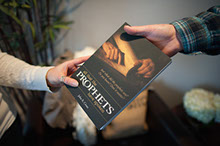BOOKS AND RESOURCES
However, if you have friends or acquaintances fluent in other languages, we encourage you to explore our translations page.
See All Translations

RESOURCES FOR DISCIPLESHIP
Here, we would also like to share some practical ways GoodSeed resources have been used by believers worldwide to disciple others in the message of the gospel.
USED TO TRAIN YOUR FAMILY
There are parents, grandparents and other parental figures who share the good news with the children in their lives using GoodSeed tools. This is what some of them do:
- For ages 5-10: The Lamb Picture Book with CD. Adults read one chapter a day over 10 days, two chapters a day for five days or complete the book in one sitting. Children follow along by answering the questions at the end of each chapter and enjoying the illustrations. Adults often get the chidren to retell the story to them, checking for understanding. The story is reinforced by regularly playing the audio CD to the children.

- For ages 10 and up: The Stranger on the Road to Emmaus. Adults set aside time each day or several times a week to read the book aloud with the children. Often, the parent reads the commentary while the children read the Bible verses. This allows Scripture to impact the children most directly. This works best if each person has a book or if one book is shared by two. Some take the time to do this immediately after breakfast; others do so after the evening meal or just before bedtime. An extended period of time on the weekends has worked well for others while some have found vacation periods to be the best. At the end of each section, check if your children understand by asking them to summarize the key points
- For adult children: The Stranger on the Road to Emmaus. If your children are grown or prefer to read the book for themselves, give each of them a personal copy. If you have one copy, you can read the book first and then pass it to them. If you have more than one copy, track along with them so the content is also fresh in your mind. Actively engage them in conversation as they read through the book. Allow them to ask questions they may have. Refrain from answering questions the book will cover until they finish reading the book. Once they have finished, set aside time to ask them what they think.
USED TO TRAIN YOUR CHURCH
In this section, we look at how you can use GoodSeed resources to help your church gain a clear understanding of the gospel and then train your congregation to share the gospel. We make no claims to having all the answers to the many challenges churches face. However, we want to share some strategies we have seen work well in different church environments.
The important thing to note is that the objective here is first to disciple, but ultimately it is to impart practical ideas of how your congregation can be actively evagelizing.
STAGE 1: "SOLIDIFY"
Create strong foundations in understanding the gospel. This initial stage involves getting your congregation on the same page with regards to the gospel. Often, it acts to rekindle in the hearts of mature believers excitement in the significance and power of the gospel message. (2 Peter 1:12-13). If starting from just one leader, this leader will gather a small group. Together they read through The Stranger on the Road to Emmaus. Later on, each group member, modeling exactly what the first leader did, will teach another group. Again, each member of this new group will teach a third set of groups. This goes on until as many people as possible in the congregation is covered.
One pastor told us how he did it with his congregation. He led the first course with the church elders while his wife lead a second study with their wives. They met once a week for several hours, finishing the class in eight weeks. Subsequently, these leaders led small groups, teaching in pairs until everyone in church had completed the course.
Other options include:
- Small groups: using the existing small group structure, get each group to use the resource as the curriculum
- Retreats or church camps: A three-day intensive weekend or retreat for the church. Start on a Friday evening and finish on a Sunday. A camp or a similar venue will make this a great getaway event, providing an unique opportunity for your members to get into the Word and fellowship with one another.
- Seminars: Some have arranged for the course to be completed over a period of three consecutive Saturdays, five hours each time. Others have used two three-hour blocks on Thursday and Friday nights, then a full day on Saturday. Others have taught this over 8 weeks, once a week.
- Adult Sunday school class: If your church offers adult classes, you can consider this venue.
STAGE 2: REACH IN TO CHURCH VISITORS
Identify people in the congregation who have gone thorugh the study and would be happy to befriend newcomers and visitors to the church. Invite these new comers and visitors to a do a study, whether one-on-one on in a small group. As the course progresses, the leader should introduce the visitor to other members. The goal here is to build bridges between the visitor and the congregation. At the end of the course, the leaders should discuss with the visitor if he or she has understood the message. If the visitor has questions, offer to do follow-up sessions to address them. If the visitor demonstrates understanding (the curriculum explains how to check for this), encourage him or her to continue their learning journey within a small group and the weekly services. Ensure that a leader or befriender keeps in touch with the visitor.

STAGE 3: REACH OUT TO THE COMMUNITY
Ultimately, the purpose of the church is to be reaching its community, to be the light and salt right where it is located. The Bible gives us the mandate to “go into all the world and proclaim the gospel to the whole creation” (Mark 16:15 ESV). So rather than just bringing people to church, the church needs to step into the community to share the gospel.
Some tried and tested ideas include:
- Community-centered studies: Stepping into the community, your church can offer courses at public libraries, community centres, senior housing communities, nursing homes, learning centres and of course, your own church.
- Home-based studies: Encourage your congregation to invite friends, family, loved ones, neighbours and co-workers to a course in their homes. Sometimes, unbelievers will be unwilling to step into church, but may be willing to learn about the Bible in the comfort of a friend’s home.
For more ideas on how GoodSeed tools can help in short-term mission training, reaching seniors and in prisons ministry, please contact our office.




